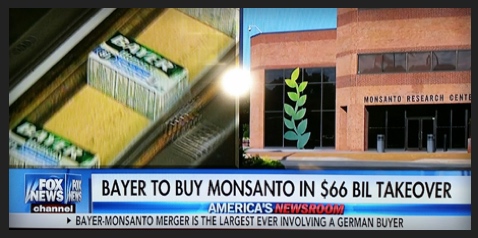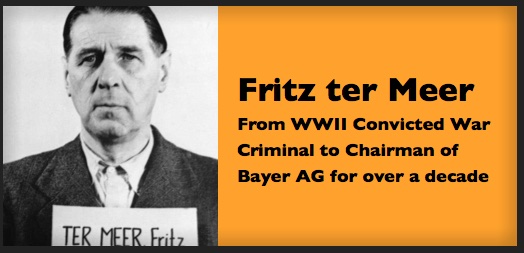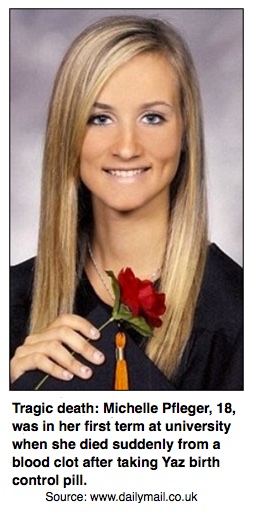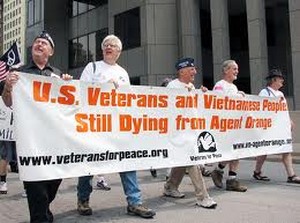Bayer-Monsanto: A “Marriage Made in Hell”?
Monsanto has agreed to be sold to Bayer for $56.5 billion
− a deal worth a total of $66 billion when Monsanto’s debt is taken
into account. The combined company would be the world’s largest seller
of both seeds and agrichemicals.
Monsanto, arguably the most loathed GMO company on the face of the earth, has been the subject of heated discussions for decades, especially in recent days as their top-selling product (RoundUp) contains glyphosate, which has been linked to cancer, autism, and respiratory sickness.
Monsanto has lobbied widely and even filed lawsuits to prohibit labeling of GMO products and bury the World Health Organization’s report listing glyphosate as a probable carcinogen. If Monsanto joins forces with Bayer (one of the most hated Big Pharma companies in the world), the resulting “marriage made in hell” would be a drug-seed-pesticide company that controls almost 1/3 of the world’s seed market and almost ¼ of the pesticide market. Many would argue that this would equate to a monopoly. More on that topic later in the article.

But this would not be the first time Monsanto and Bayer have teamed up. During the Vietnam War, both firms were involved in the development of Agent Orange. And both firms are currently involved in the GMO market today. Speaking of GMOs, I was watching Fox News Channel a couple of days ago and the “expert” being interviewed said that this was necessary in order to feed the world and that GMO foods are the only solution. WRONG!
Apparently said “expert” is unfamiliar with the recent research, specifically the IAASTD Report, which is the most comprehensive report on the future of food and agriculture (sponsored by the World Bank and the UN, written by over 400 scientists and endorsed by 59 countries).
In this report, they did not endorse GMOs as a solution to world hunger. In addition, genetic engineering has not significantly increased U.S. crop yields, according to the USDA and controlled comparative studies. As a matter of fact, many GMOs have lower yields than non-GMO crops. Did I mention that GMO crops have been linked to cancer and have numerous potential health risks?
Let’s look at the sordid history of both of these companies…
• During World War 1, Bayer turned its attention to the manufacture of chemical weapons including chlorine gas.
• In 1925, Bayer, BASF, and Hoechst merged to form the massive German conglomerate Interessengemeinschaft Farben (IG Farben) which was the single biggest donor to Hitler’s election campaign.
• IG Farben built the concentration camps at Auschwitz to supply slave labor for the nearby IG Farben plant (also known as IG Auschwitz). Hitler eventually used these same camps in his megalomaniacal attempt to exterminate the Jewish race.
• In 1941, Otto Armbrust, the IG Farben board member responsible for IG Farben’s Auschwitz project, told his colleagues, “our new friendship with the SS is a blessing. We have determined all measures integrating the concentration camps to benefit our company.”
• A subsidiary of IG Farben manufactured and supplied Zyklon B to the SS. This poisonous cyanide-based pesticide, on which IG Farben held the patent, was used during the Holocaust to annihilate more than 1,000,000 people in the concentration/extermination camps. IG Farben also supplied the SS with the Methanol used to burn the corpses.
• In 1946, the Nuremberg War Crimes Tribunal concluded that without IG Farben the Second World War would simply not have been possible.
• At Nuremberg, Fritz ter Meer
(an executive of IG Farben) was convicted of slavery, mass murder, and
crimes against humanity. After serving 5 years in prison, he became
Chairman of the Board at Bayer in 1956, a position which he held for
almost a decade.
Meer
(an executive of IG Farben) was convicted of slavery, mass murder, and
crimes against humanity. After serving 5 years in prison, he became
Chairman of the Board at Bayer in 1956, a position which he held for
almost a decade.
• In 1962, just fifteen years after they were convicted in the Nuremberg War Crimes Tribunal, Bayer, BASF and Hoechst were again the architects of the next major human rights offence when they established the Codex Alimentarius Commission.
• In the mid-1980s, Bayer was one of the companies which sold a product called Factor VIII concentrate to treat hemophilia. Factor VIII turned out to be infected with HIV. After learning that the product was contaminated, in order to save money, Bayer continued selling this infected product to Asia and Latin America even though a safe product was available. Dr. Sidney M. Wolfe, who investigated the scandal, commented, “These are the most incriminating internal pharmaceutical industry documents I have ever seen.”
• In the 1990s, the federal government launched an investigation on Bayer’s unethical billing practices on Medicaid program and the Department of Justice found Bayer guilty of fraud. Bayer had to pay $14 Million to settle charges of causing inflated Medicaid claims.
 •
Yaz (approved by FDA in 2006) and Yasmin (2001) were revolutionary
birth control pills that use a synthetic hormone called drospirenone
(DSP). Yaz or Yasmin have led to hundreds of deaths in young and healthy
women.
•
Yaz (approved by FDA in 2006) and Yasmin (2001) were revolutionary
birth control pills that use a synthetic hormone called drospirenone
(DSP). Yaz or Yasmin have led to hundreds of deaths in young and healthy
women.
• The drug Trasylol was banned in 2006 after it contributed to thousands of deaths in patients every single month for over a decade. After a 2006 study showed widespread deaths associated with Trasylol, it took FDA and Bayer almost two years to take the drug off of the market. Later on it was revealed that Bayer had buried evidence of Trasylol’s severe side effects.
• In 2008, the German Coalition against Bayer brought a charge against the Bayer Board of Management, with the public prosecutor in Freiburg accusing Bayer of contributing to the mass death of bees all over the world through its aggressive pesticide marketing. Since then, the bee debacle has only grown worse, with thousands of hives collapsing after poisoning by the pesticide clothianidin, producing a worldwide crisis.
Thanks to this website and this website for much of the above information.
• In the 1920s, Monsanto Chemical Company was founded and incorporated the town of Monsanto, later renamed Sauget, Illinois. For years, the Monsanto plant in Sauget was the nation’s largest producer of polychlorinated biphenyls (PCBs), which were banned in the 1970s. PCBs are potent carcinogens and have been implicated in reproductive, developmental and immune system disorders. According to thousands of pages of released Monsanto documents (many of them emblazoned with warnings such as “CONFIDENTIAL: Read and Destroy”), they knew about the PCB dangers from early on, but decided to conceal what they knew. One Monsanto memo explains their justification: “We can’t afford to lose one dollar of business.”
• During World War II, Monsanto played a significant role in the Manhattan Project to develop the atom bomb.
• In 1944, Monsanto began manufacturing DDT, which was banned in 1972.
• Following World War II, Monsanto championed the use of chemical pesticides in agriculture, and began manufacturing the herbicide 2,4,5-T, which contains dioxin. During the Vietnam War, the U.S. military initiated an herbicidal warfare program using Agent Orange (a mixture of 2,4,5-T and 2,4-D and had very high concentrations of dioxin) as a defoliant.
 Monsanto
and Dow Chemical were the two largest producers of Agent Orange, which
has been linked to cancer and birth defects. According to the Vietnamese
Ministry of Foreign Affairs, 4.8 million Vietnamese people were exposed
to Agent Orange, resulting in 400,000 deaths and disabilities,
plus 500,000 children born with birth defects, leading to calls for
Monsanto to be prosecuted for war crimes. Internal Monsanto memos show
that Monsanto knew of the problems of dioxin contamination of Agent
Orange when it sold it to the U.S. government for use in Vietnam.
Monsanto
and Dow Chemical were the two largest producers of Agent Orange, which
has been linked to cancer and birth defects. According to the Vietnamese
Ministry of Foreign Affairs, 4.8 million Vietnamese people were exposed
to Agent Orange, resulting in 400,000 deaths and disabilities,
plus 500,000 children born with birth defects, leading to calls for
Monsanto to be prosecuted for war crimes. Internal Monsanto memos show
that Monsanto knew of the problems of dioxin contamination of Agent
Orange when it sold it to the U.S. government for use in Vietnam.
• In 1973, Monsanto developed and patented the glyphosate molecule and began manufacturing Roundup. In 2015, the World Health Organization declared glyphosate to be a probable carcinogen. Despite this fact, Roundup is still marketed as “safe.”
• In 1982, Monsanto genetically modified a plant cell for the first time.
• In the mid-1980s, Monsanto purchased G.D. Searle, the chemical company that held the patent to aspartame, the active ingredient in NutraSweet. Monsanto was apparently untroubled by aspartame’s clouded past, including a 1980 FDA Board of Inquiry, comprised of three independent scientists, which confirmed that it “might induce brain tumors.” The aspartame business became a separate Monsanto subsidiary, the NutraSweet Company.
• In the late-1980s and early-1990s, Monsanto spent almost $500,000 to defeat Proposition 65 (California’s anti-toxics initiative which prohibited the discharge of chemicals known to cause cancer or birth defects into drinking water supplies) and Proposition 128 (California’s pesticide regulation initiative that would have phased out Monsanto’s product alachlor, which is linked to cancer). During the same time period, Monsanto also conducted the first field tests of genetically engineered (GMO) crops.
• In 1991, Monsanto was fined $1.2 million for trying to conceal discharge of contaminated waste water into the Mystic River in Connecticut.
• In the mid-1990s, Monsanto developed their controversial cattle drug, recombinant bovine growth hormone (rBGH or rBST), which is produced through a genetically engineered E. coli bacteria.
• During the same time period, Monsanto was ranked 5th among U.S. corporations in EPA’s Toxic Release Inventory, having discharged 37 million pounds of toxic chemicals into the air, land, water and underground. Monsanto was ordered to pay $41.1 million to a waste management company in Texas due to concerns over hazardous waste dumping.
• In 1996, Monsanto introduced “Roundup Ready Soybeans” and “BT Cotton” then in 1998 “Roundup Ready Corn” was introduced.
• By 2007, Monsanto’s GMO seeds accounted for over 90% of the world’s supply.
• In 2010, former Monsanto lobbyist Michael R. Taylor was appointed as Deputy Commissioner of Food Safety at the FDA (the fox is guarding the henhouse).
• Since 2012, Monsanto has spent more than $25 million to fight state ballot initiatives to label GMOs and millions more to lobby Congress against mandatory GMO labeling.
Thanks to this website for much of the above information.
If these two companies join forces, the dark and dangerous synergy and malignant power will metastasize and be so great that, figuratively speaking, the universe might explode! To use a Lord of the Rings analogy, it would be like Sauron acquiring the One Ring.
Will this merger actually happen? It’s hard to say. Thankfully, there are anti-trust laws in place that will force the entire deal to undergo tremendous scrutiny and lengthy regulatory processes in the USA as well as the EU. “This merger is not a slam dunk,” said Diana Moss, president of the American Antitrust Institute. Also, a legal opinion written by two former Department of Justice officials (Antitrust Division) argues that the merger would violate the Clayton Act and would also be in direct violation of a 2008 court order.
 A
Bayer-Monsanto merger certainly threatens the world food supply with
domination by GMOs and destructive, carcinogenic agrochemicals. Thanks
primarily to the anti-GMO and “Millions Against Monsanto” movements, the
behemoth biotech bully is on the ropes.
A
Bayer-Monsanto merger certainly threatens the world food supply with
domination by GMOs and destructive, carcinogenic agrochemicals. Thanks
primarily to the anti-GMO and “Millions Against Monsanto” movements, the
behemoth biotech bully is on the ropes.
Perhaps Monsanto thinks that if it changes its name, that we will forget its poisonous past. Think again Monsanto.
On October 14-16, Monsanto’s crimes against humanity will be exposed at the Monsanto Tribunal in The Hague, Netherlands.
Remember, all it takes for evil to prevail is for good men to do nothing. We must stick together and help educate our neighbors in order to continue the good fight together… for our children and every future generation to come.
Perhaps it’s time to put Bayer and Big Pharma on trial as well and build an even bigger worldwide unified assembly. Maybe we could call it “Billions Against Big Pharma and Bayer-Monsanto.”
Please share this important news story with friends and family and together let’s all take action to stop this merger.

Monsanto, arguably the most loathed GMO company on the face of the earth, has been the subject of heated discussions for decades, especially in recent days as their top-selling product (RoundUp) contains glyphosate, which has been linked to cancer, autism, and respiratory sickness.
Monsanto has lobbied widely and even filed lawsuits to prohibit labeling of GMO products and bury the World Health Organization’s report listing glyphosate as a probable carcinogen. If Monsanto joins forces with Bayer (one of the most hated Big Pharma companies in the world), the resulting “marriage made in hell” would be a drug-seed-pesticide company that controls almost 1/3 of the world’s seed market and almost ¼ of the pesticide market. Many would argue that this would equate to a monopoly. More on that topic later in the article.

But this would not be the first time Monsanto and Bayer have teamed up. During the Vietnam War, both firms were involved in the development of Agent Orange. And both firms are currently involved in the GMO market today. Speaking of GMOs, I was watching Fox News Channel a couple of days ago and the “expert” being interviewed said that this was necessary in order to feed the world and that GMO foods are the only solution. WRONG!
Apparently said “expert” is unfamiliar with the recent research, specifically the IAASTD Report, which is the most comprehensive report on the future of food and agriculture (sponsored by the World Bank and the UN, written by over 400 scientists and endorsed by 59 countries).
In this report, they did not endorse GMOs as a solution to world hunger. In addition, genetic engineering has not significantly increased U.S. crop yields, according to the USDA and controlled comparative studies. As a matter of fact, many GMOs have lower yields than non-GMO crops. Did I mention that GMO crops have been linked to cancer and have numerous potential health risks?
Let’s look at the sordid history of both of these companies…
A Brief History of BAYER
• Founded in Barmen, Germany in 1863 by Friedrich Bayer and his partner, Johann Friedrich Weskott.• During World War 1, Bayer turned its attention to the manufacture of chemical weapons including chlorine gas.
• In 1925, Bayer, BASF, and Hoechst merged to form the massive German conglomerate Interessengemeinschaft Farben (IG Farben) which was the single biggest donor to Hitler’s election campaign.
• IG Farben built the concentration camps at Auschwitz to supply slave labor for the nearby IG Farben plant (also known as IG Auschwitz). Hitler eventually used these same camps in his megalomaniacal attempt to exterminate the Jewish race.
• In 1941, Otto Armbrust, the IG Farben board member responsible for IG Farben’s Auschwitz project, told his colleagues, “our new friendship with the SS is a blessing. We have determined all measures integrating the concentration camps to benefit our company.”
• A subsidiary of IG Farben manufactured and supplied Zyklon B to the SS. This poisonous cyanide-based pesticide, on which IG Farben held the patent, was used during the Holocaust to annihilate more than 1,000,000 people in the concentration/extermination camps. IG Farben also supplied the SS with the Methanol used to burn the corpses.
• In 1946, the Nuremberg War Crimes Tribunal concluded that without IG Farben the Second World War would simply not have been possible.
• At Nuremberg, Fritz ter
 Meer
(an executive of IG Farben) was convicted of slavery, mass murder, and
crimes against humanity. After serving 5 years in prison, he became
Chairman of the Board at Bayer in 1956, a position which he held for
almost a decade.
Meer
(an executive of IG Farben) was convicted of slavery, mass murder, and
crimes against humanity. After serving 5 years in prison, he became
Chairman of the Board at Bayer in 1956, a position which he held for
almost a decade.• In 1962, just fifteen years after they were convicted in the Nuremberg War Crimes Tribunal, Bayer, BASF and Hoechst were again the architects of the next major human rights offence when they established the Codex Alimentarius Commission.
• In the mid-1980s, Bayer was one of the companies which sold a product called Factor VIII concentrate to treat hemophilia. Factor VIII turned out to be infected with HIV. After learning that the product was contaminated, in order to save money, Bayer continued selling this infected product to Asia and Latin America even though a safe product was available. Dr. Sidney M. Wolfe, who investigated the scandal, commented, “These are the most incriminating internal pharmaceutical industry documents I have ever seen.”
• In the 1990s, the federal government launched an investigation on Bayer’s unethical billing practices on Medicaid program and the Department of Justice found Bayer guilty of fraud. Bayer had to pay $14 Million to settle charges of causing inflated Medicaid claims.
 •
Yaz (approved by FDA in 2006) and Yasmin (2001) were revolutionary
birth control pills that use a synthetic hormone called drospirenone
(DSP). Yaz or Yasmin have led to hundreds of deaths in young and healthy
women.
•
Yaz (approved by FDA in 2006) and Yasmin (2001) were revolutionary
birth control pills that use a synthetic hormone called drospirenone
(DSP). Yaz or Yasmin have led to hundreds of deaths in young and healthy
women.• The drug Trasylol was banned in 2006 after it contributed to thousands of deaths in patients every single month for over a decade. After a 2006 study showed widespread deaths associated with Trasylol, it took FDA and Bayer almost two years to take the drug off of the market. Later on it was revealed that Bayer had buried evidence of Trasylol’s severe side effects.
• In 2008, the German Coalition against Bayer brought a charge against the Bayer Board of Management, with the public prosecutor in Freiburg accusing Bayer of contributing to the mass death of bees all over the world through its aggressive pesticide marketing. Since then, the bee debacle has only grown worse, with thousands of hives collapsing after poisoning by the pesticide clothianidin, producing a worldwide crisis.
Thanks to this website and this website for much of the above information.
MONSANTO’S Poisonous Past
• Monsanto was founded in 1901 in St. Louis, Missouri, by John Francis Queeny, a 30-year veteran of the pharmaceutical industry. Its first product was the artificial sweetener Saccharin, which Monsanto sold to the Coca-Cola Company.• In the 1920s, Monsanto Chemical Company was founded and incorporated the town of Monsanto, later renamed Sauget, Illinois. For years, the Monsanto plant in Sauget was the nation’s largest producer of polychlorinated biphenyls (PCBs), which were banned in the 1970s. PCBs are potent carcinogens and have been implicated in reproductive, developmental and immune system disorders. According to thousands of pages of released Monsanto documents (many of them emblazoned with warnings such as “CONFIDENTIAL: Read and Destroy”), they knew about the PCB dangers from early on, but decided to conceal what they knew. One Monsanto memo explains their justification: “We can’t afford to lose one dollar of business.”
• During World War II, Monsanto played a significant role in the Manhattan Project to develop the atom bomb.
• In 1944, Monsanto began manufacturing DDT, which was banned in 1972.
• Following World War II, Monsanto championed the use of chemical pesticides in agriculture, and began manufacturing the herbicide 2,4,5-T, which contains dioxin. During the Vietnam War, the U.S. military initiated an herbicidal warfare program using Agent Orange (a mixture of 2,4,5-T and 2,4-D and had very high concentrations of dioxin) as a defoliant.
 Monsanto
and Dow Chemical were the two largest producers of Agent Orange, which
has been linked to cancer and birth defects. According to the Vietnamese
Ministry of Foreign Affairs, 4.8 million Vietnamese people were exposed
to Agent Orange, resulting in 400,000 deaths and disabilities,
plus 500,000 children born with birth defects, leading to calls for
Monsanto to be prosecuted for war crimes. Internal Monsanto memos show
that Monsanto knew of the problems of dioxin contamination of Agent
Orange when it sold it to the U.S. government for use in Vietnam.
Monsanto
and Dow Chemical were the two largest producers of Agent Orange, which
has been linked to cancer and birth defects. According to the Vietnamese
Ministry of Foreign Affairs, 4.8 million Vietnamese people were exposed
to Agent Orange, resulting in 400,000 deaths and disabilities,
plus 500,000 children born with birth defects, leading to calls for
Monsanto to be prosecuted for war crimes. Internal Monsanto memos show
that Monsanto knew of the problems of dioxin contamination of Agent
Orange when it sold it to the U.S. government for use in Vietnam.• In 1973, Monsanto developed and patented the glyphosate molecule and began manufacturing Roundup. In 2015, the World Health Organization declared glyphosate to be a probable carcinogen. Despite this fact, Roundup is still marketed as “safe.”
• In 1982, Monsanto genetically modified a plant cell for the first time.
• In the mid-1980s, Monsanto purchased G.D. Searle, the chemical company that held the patent to aspartame, the active ingredient in NutraSweet. Monsanto was apparently untroubled by aspartame’s clouded past, including a 1980 FDA Board of Inquiry, comprised of three independent scientists, which confirmed that it “might induce brain tumors.” The aspartame business became a separate Monsanto subsidiary, the NutraSweet Company.
• In the late-1980s and early-1990s, Monsanto spent almost $500,000 to defeat Proposition 65 (California’s anti-toxics initiative which prohibited the discharge of chemicals known to cause cancer or birth defects into drinking water supplies) and Proposition 128 (California’s pesticide regulation initiative that would have phased out Monsanto’s product alachlor, which is linked to cancer). During the same time period, Monsanto also conducted the first field tests of genetically engineered (GMO) crops.
• In 1991, Monsanto was fined $1.2 million for trying to conceal discharge of contaminated waste water into the Mystic River in Connecticut.
• In the mid-1990s, Monsanto developed their controversial cattle drug, recombinant bovine growth hormone (rBGH or rBST), which is produced through a genetically engineered E. coli bacteria.
• During the same time period, Monsanto was ranked 5th among U.S. corporations in EPA’s Toxic Release Inventory, having discharged 37 million pounds of toxic chemicals into the air, land, water and underground. Monsanto was ordered to pay $41.1 million to a waste management company in Texas due to concerns over hazardous waste dumping.
• In 1996, Monsanto introduced “Roundup Ready Soybeans” and “BT Cotton” then in 1998 “Roundup Ready Corn” was introduced.
• By 2007, Monsanto’s GMO seeds accounted for over 90% of the world’s supply.
• In 2010, former Monsanto lobbyist Michael R. Taylor was appointed as Deputy Commissioner of Food Safety at the FDA (the fox is guarding the henhouse).
• Since 2012, Monsanto has spent more than $25 million to fight state ballot initiatives to label GMOs and millions more to lobby Congress against mandatory GMO labeling.
Thanks to this website for much of the above information.
Bayer Monsanto Union: A Dark and Dangerous Threat
The above bullet points about Bayer and Monsanto are merely the tip of the iceberg. I could have written an entire book detailing the unscrupulous activities that these companies have engaged in over the past century. But I think you get the point. This “hidden” history of Bayer and Monsanto indicates that both of these companies have consistently been involved with malevolent endeavors that wreaked havoc on humanity and caused sickness, pain, and death on a massive scale. These companies are like a cancer eating away at the physical fabric of our world.If these two companies join forces, the dark and dangerous synergy and malignant power will metastasize and be so great that, figuratively speaking, the universe might explode! To use a Lord of the Rings analogy, it would be like Sauron acquiring the One Ring.
Will this merger actually happen? It’s hard to say. Thankfully, there are anti-trust laws in place that will force the entire deal to undergo tremendous scrutiny and lengthy regulatory processes in the USA as well as the EU. “This merger is not a slam dunk,” said Diana Moss, president of the American Antitrust Institute. Also, a legal opinion written by two former Department of Justice officials (Antitrust Division) argues that the merger would violate the Clayton Act and would also be in direct violation of a 2008 court order.
 A
Bayer-Monsanto merger certainly threatens the world food supply with
domination by GMOs and destructive, carcinogenic agrochemicals. Thanks
primarily to the anti-GMO and “Millions Against Monsanto” movements, the
behemoth biotech bully is on the ropes.
A
Bayer-Monsanto merger certainly threatens the world food supply with
domination by GMOs and destructive, carcinogenic agrochemicals. Thanks
primarily to the anti-GMO and “Millions Against Monsanto” movements, the
behemoth biotech bully is on the ropes.Perhaps Monsanto thinks that if it changes its name, that we will forget its poisonous past. Think again Monsanto.
On October 14-16, Monsanto’s crimes against humanity will be exposed at the Monsanto Tribunal in The Hague, Netherlands.
Remember, all it takes for evil to prevail is for good men to do nothing. We must stick together and help educate our neighbors in order to continue the good fight together… for our children and every future generation to come.
Perhaps it’s time to put Bayer and Big Pharma on trial as well and build an even bigger worldwide unified assembly. Maybe we could call it “Billions Against Big Pharma and Bayer-Monsanto.”
Please share this important news story with friends and family and together let’s all take action to stop this merger.


No comments:
Post a Comment